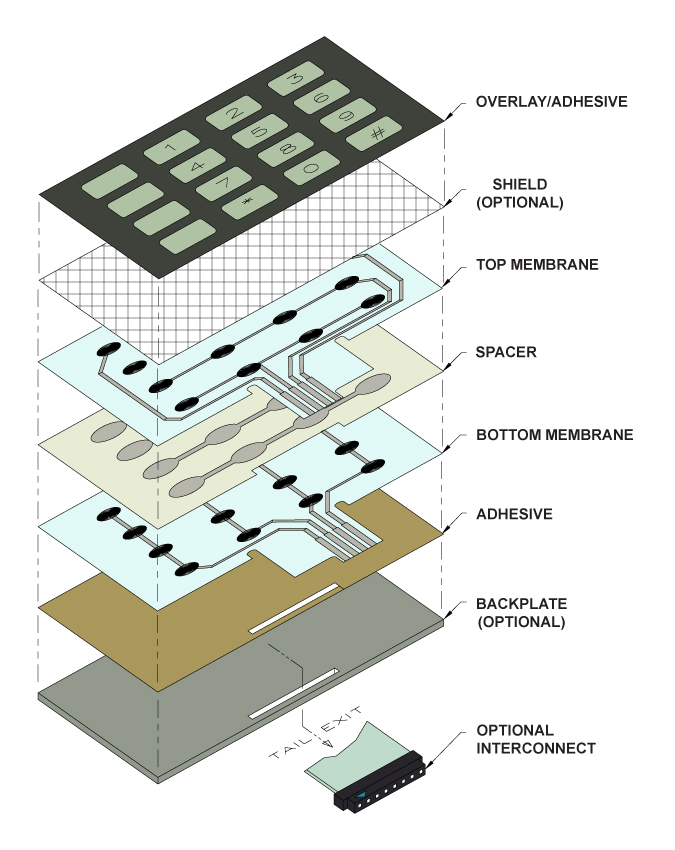How to Ensure Longevity and Reliability with a High-Quality Membrane Switch
Wiki Article
Comprehending the Functionality of Membrane Changes for User Interface Gadget
The functionality of membrane layer changes represents a substantial development in individual interface style, integrating efficiency with aesthetic adaptability. These buttons run with a multi-layered framework that equates individual communications right into electrical signals, enabling both small designs and durability versus ecological elements. As sectors increasingly focus on customer experience, comprehending the subtleties of membrane button innovation becomes crucial. What ramifications do these advancements hold for future applications, and just how might they redefine individual communications across numerous devices?What Are Membrane Layer Switches?
Membrane layer buttons are cutting-edge interface tools that facilitate user interaction with digital devices. These flexible elements include multiple layers, consisting of a visuals overlay, spacer, and a printed circuit layer. The style enables a smooth combination into numerous digital tools, enhancing both the visual and practical elements of user interfaces.
Membrane layer buttons are generally utilized in a variety of applications, from household home appliances to commercial machinery and medical devices. Their construction typically features a slim account, making them a suitable choice for compact layouts. The responsive responses provided by these switches can be engineered to meet particular customer preferences, making certain efficient communication between the user and the device.
Resilience is an additional significant benefit of membrane buttons, as they are resistant to dirt, dampness, and chemicals, which enhances their life expectancy sought after atmospheres. Furthermore, these buttons can be tailored in terms of shape, size, and visuals layout, enabling branding and user-specific functions. Generally, membrane switches over stand for a sensible solution for boosting customer experience in electronic devices, combining performance with visual charm in an efficient way.
Just How Membrane Layer Changes Job
Operating on a simple concept, membrane switches use a layered building and construction to sign up user input properly. Each switch consists of multiple layers, including a published circuit layer, a spacer layer, and a top graphic layer, which are created to interact effortlessly. When an individual presses the top layer, it compresses the spacer layer, bringing the conductive components of the circuit layer right into contact with each various other.This call produces a shut circuit, indicating the tool to perform a specific feature. The layout permits various setups, consisting of responsive feedback, which can improve the individual experience by offering a physical sensation upon activation. The products used in membrane layer switches commonly include flexible substratums, such as polyester or polycarbonate, which make certain durability and resilience versus damage.

Key Benefits of Membrane Switches

One more significant advantage is their density. Membrane switches are thin and light-weight, which allows manufacturers to conserve space in their devices without compromising functionality. This attribute is particularly valuable in applications where weight and volume are critical factors to consider.
Additionally, membrane layer buttons are immune to dust, moisture, and chemicals, enhancing their resilience. This resilience extends their life-span and decreases the requirement for regular replacements, causing cost savings with time.
Moreover, the responsive comments offered by membrane switches can be enhanced to improve individual communication. They can consist of features such as raised buttons or distinct clicks, improving usability and customer experience.
Applications Across Industries
Interface tools utilizing membrane layer switches prevail in a wide range of industries, showcasing their versatility and capability. Membrane Switch. In the medical industry, membrane buttons are indispensable to devices such as diagnostic devices and person monitoring systems, where their toughness and simplicity of cleaning are essential for preserving hygiene requirements. Likewise, in the automobile industry, these switches are employed in dashboard controls and infotainment systems, offering a sleek and contemporary user interface for individuals.Furthermore, the customer electronic devices field advantages from membrane switches in devices and handheld tools, where compact style and user-friendly interfaces enhance individual experience. Industrial applications also leverage membrane layer changes for control panels in machinery and automation systems, highlighting their toughness and resistance to rough settings.
In the aerospace and defense markets, membrane buttons are utilized in cabin controls and equipment, where reliability and efficiency under severe conditions are extremely important. In addition, the video gaming market significantly integrates membrane switches in controllers and arcade equipments, adding to an appealing customer experience. On the whole, visit the flexibility of membrane switches over allows their widespread usage across various fields, underscoring their value in modern interface layout.
Future Patterns in Membrane Switch Technology

In addition, the usage of advanced materials, such as polycarbonate and polyester movies, is expected to climb, offering boosted longevity and resistance to environmental stress factors. These materials add to the total longevity of membrane switches, making them ideal for harsher commercial applications.
Moreover, sites the consolidation of wise modern technology, including IoT connectivity, will certainly allow membrane layer buttons to connect with various other devices and systems, promoting a more interactive individual experience. This trend aligns with the expanding demand for wise tools across different fields, from healthcare to consumer electronics.
Last but not least, modification alternatives are anticipated to expand, allowing manufacturers to produce bespoke remedies customized to specific user requirements and choices. These developments will position membrane layer buttons as important elements in the advancement of interface modern technology.
Final Thought
In final thought, membrane layer switches represent a pivotal innovation in individual interface modern technology, supplying a reliable and versatile remedy for diverse electronic applications. As improvements in material science and touch picking up useful site modern technologies continue, the capability and applicability of membrane switches are anticipated to expand, strengthening their relevance in modern electronic tools.
Report this wiki page